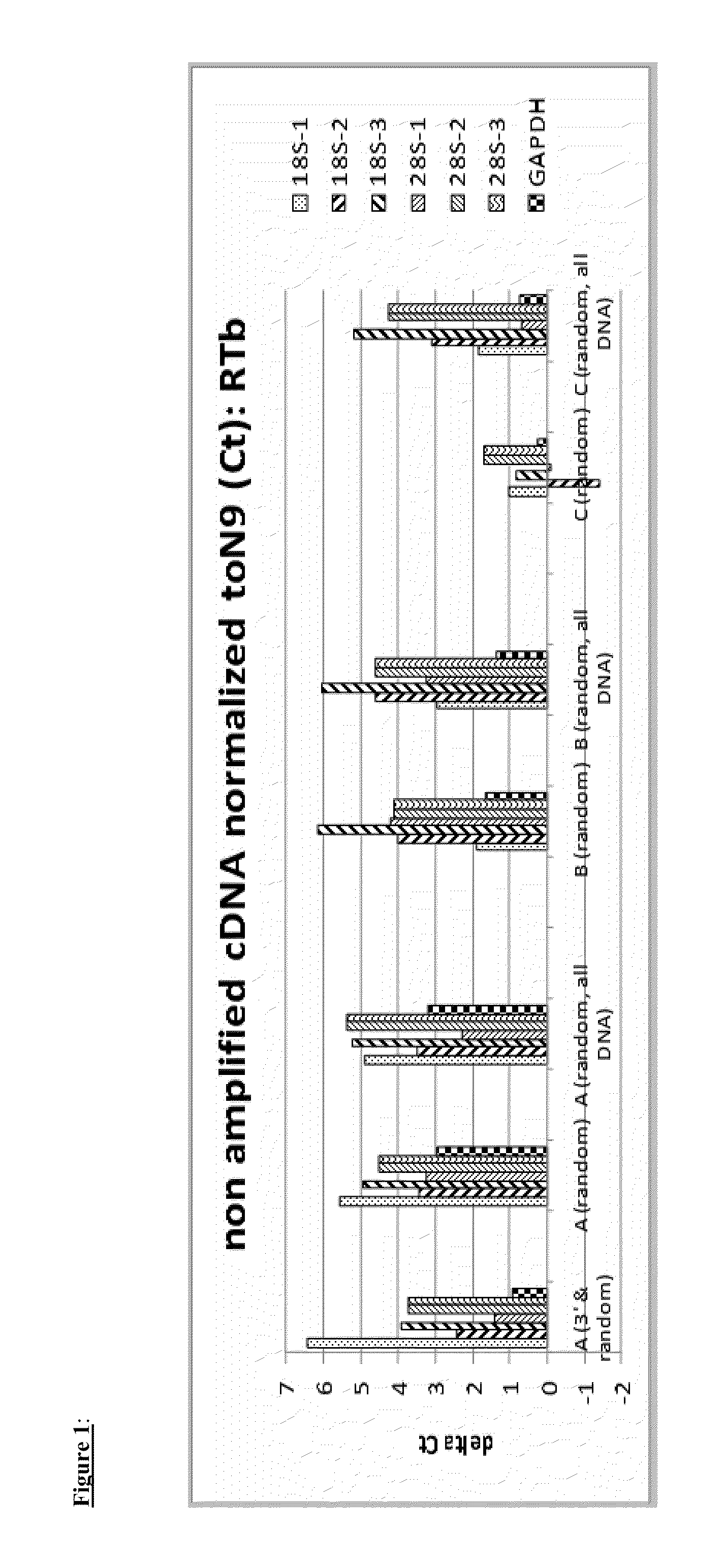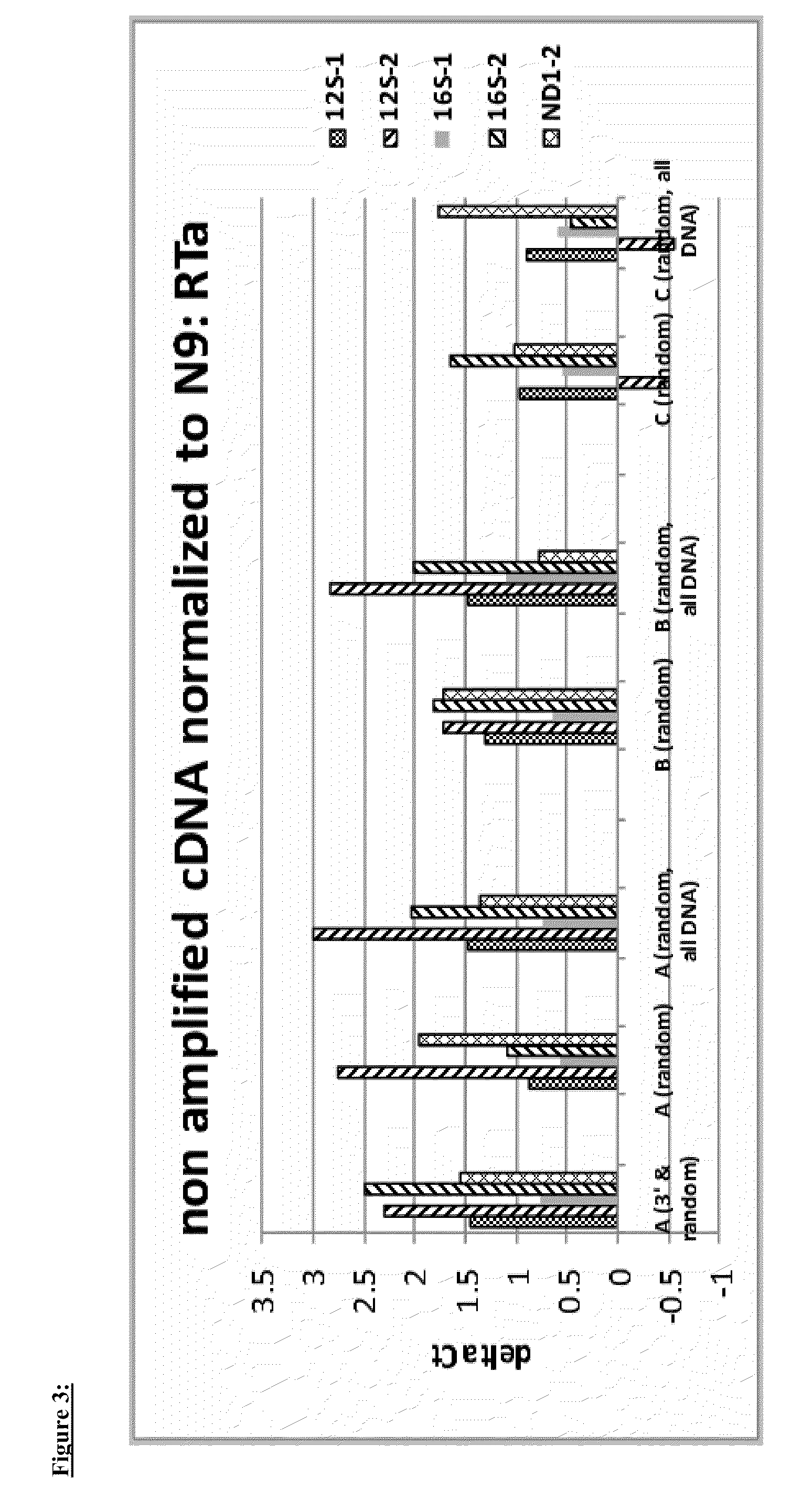Compositions and methods for whole transcriptome analysis
a whole transcriptome and transcript technology, applied in the field of whole transcriptome analysis, can solve the problems of rrna presence, degradation and loss of mrna transcripts in the sample, and may be detrimental to many downstream applications, and achieve the effect of reducing or substantial elimination of ribosomal rna (rrna) representation
- Summary
- Abstract
- Description
- Claims
- Application Information
AI Technical Summary
Benefits of technology
Problems solved by technology
Method used
Image
Examples
example 1
[0078]Reaction Conditions and Reagents:
[0079]In this example cDNA was generated from total RNA (10 ng total Brain RNA, Ambion). First strand cDNA was generated using a variety of tailed first primers, which differ in the 5′-tail sequence. Two different reverse transcriptases (RTa and RTb) were used with the various first strand primers. The reaction conditions, both buffer compositions and incubation conditions, were selected for the given RT according to the manufacturer's suggestions. For RTa in this and the following example, first and second cDNA reagents and reaction conditions were those of Ovation Pico (NuGEN Technologies). The RTb reagents and reaction conditions were those of Ovation One Direct RNA amplification (NuGEN Technologies). The various first strand primers employed in the example comprise a 3′-end random hexamer sequence. First strand primers A, B, and C were tested, as well as a mixture of primer A comprising random hexamer at the 3′-end and a primer comprising a...
example 2
[0089]This example describes reduction in the representation of rRNA in amplified cDNA from C. elegans total RNA. Non-amplified cDNA was prepared priming with Primer A (3′& random) or Primer B (3′& random) and RTa or RTb and using first and second strand reagents and protocol. Total C. elegans RNA input was 2 ng. The cDNA was further amplified with two different reagent and protocol systems: SPIA amplification using reagents and protocols from the Ovation Pico kit (NUGEN) or reagents and protocol from WGA-Ovation kit (NuGEN). rRNA and non rRNA cDNA in the double stranded cDNA generated by the different primer sets, RT and protocols were quantified by qPCR as described in Example 1.
[0090]FIGS. 15 and 16 represent the delta CT (dCT) of quantification of the same transcript loci in amplified cDNA prepared with different first strand RT and amplified with the same SPIA amplification reagents and protocols. Similar differential reduction of rRNA, but not non rRNA or mRNA, is observed in ...
example 3
[0093]This example describes differential reduction in rRNA representation in amplified cDNA from C. elegans total RNA as measured by mass normalized quantification by qPCR and massively parallel sequencing (RNA-Seq) using Illumina's Genome Analyzer.
[0094]Quantification of rRNA and mRNA in purified amplification products generated by RTa (Ovation Pico cDNA) with two primer sets demonstrate the reduction of rRNA representation in the products generated with one of the two primer sets relative to the other. The effect is independent of the SPIA amplification reagent and conditions, as demonstrated by results from products generated using the reagents and conditions for SPIA amplification reaction from the Ovation Pico or WG-Ovation kits.
[0095]Quantification by qPCR of rRNA was carried out with 10 pg input (amplified products) and that of the mRNA transcripts with 10 ng input (amplified products). The corrected dCt reflects the correction of the rRNA values to 10 ng input (mass normali...
PUM
| Property | Measurement | Unit |
|---|---|---|
| Mass | aaaaa | aaaaa |
| Mass | aaaaa | aaaaa |
| Fraction | aaaaa | aaaaa |
Abstract
Description
Claims
Application Information
 Login to View More
Login to View More - R&D
- Intellectual Property
- Life Sciences
- Materials
- Tech Scout
- Unparalleled Data Quality
- Higher Quality Content
- 60% Fewer Hallucinations
Browse by: Latest US Patents, China's latest patents, Technical Efficacy Thesaurus, Application Domain, Technology Topic, Popular Technical Reports.
© 2025 PatSnap. All rights reserved.Legal|Privacy policy|Modern Slavery Act Transparency Statement|Sitemap|About US| Contact US: help@patsnap.com



